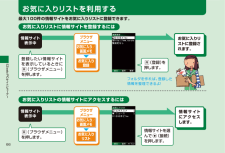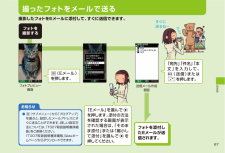
11


153 / 164 ページ
現在のページURL
OF USE, DATA, OR PROFITS; OR BUSINESS INTERRUPTION)HOWEVER CAUSED AND ON ANY THEORY OF LIABILITY, WHETHER IN CONTRACT, STRICT LIABILITY, OR TORT (INCLUDING NEGLIGENCE OR OTHERWISE) ARISING IN ANY WAY OUT OF THE USE OF THIS SOFTWARE, EVEN IF ADVISED OF THE POSSIBILITY OF SUCH DAMAGE.FCC NoticeThis device complies with part 15 of the FCC Rules. Operation is subject to the following two conditions: (1) This device may not cause harmful interference, and (2) this device must accept any interference received, including interference that may cause undesired operation.Note:This equipment has been tested and found to comply with the limits for a Class B digital device, pursuant to part 15 of the FCC Rules. These limits are designed to provide reasonable protection against harmful interference in a residential installation. This equipment generates, uses, and can radiate radio frequency energy and, if not installed and used in accordance with the instructions, may cause harmful interference to radio communications. However, there is no guarantee that interference will not occur in a particular installation. If this equipment does cause harmful interference to radio or television reception, which can be determined by turning the equipment off and on, the user is encouraged to try to correct the interference by one or more of the following measures:- Reorient or relocate the receiving antenna.- Increase the separation between the equipment and receiver.- Connect the equipment into an outlet on circuit different from that to which the receiver is connected.- Consult the dealer or an experienced radio/TV technician for help and for additional suggestions.WarningThe user is cautioned that changes or modifications not expressly approved by the manufacturer could void the user's authority to operate the equipment. FCC RF EXPOSURE INFORMATIONWarning! Read this information before using your phone.In August 1996, the Federal Communications Commission (FCC) of the United States, with its action in Report and Order FCC 96-326, adopted an updated safety standard for human exposure to radio frequency electromagnetic energy emitted by FCC regulated transmitters. Those guidelines are consistent with the safety standard previously set by both U.S. and international standards bodies. The design of this phone complies with the FCC guidelines and these international standards.Specific Absorption Rate (SAR) for Wireless PhonesThe exposure standard for wireless handsets employs a unit of measurement known as the Specific Absorption Rate, or SAR. The SAR limit set by the FCC is 1.6 W/kg.The tests are performed in positions and locations (e.g., at the ear and worn on the body) as required by the FCC for each model. The highest SAR value for this model handset when tested for use at the ear is 0.385 W/kg and when worn on the body, as described in this user guide, is 0.561 W/kg.Body-worn OperationThis device was tested for typical body-worn operations with the back of the phone kept 0.59 inches (1.5 cm) from the body. To comply with FCC RF exposure requirements, a minimum separation distance of 0.59 inches (1.5 cm) must be maintained between the user's body and the back of the phone, including the antenna. All beltclips, holsters and similar accessories used by this device must not contain any metallic components. Body-worn accessories that do not meet these requirements may not comply with FCC RF exposure limits and should be avoided.Turn off your phone before flyingYou should turn off your phone when boarding any aircraft. To prevent possible interference with aircraft systems, U.S. Federal Aviation Administration (FAA) regulations require you to have permission from a crew member to use your phone while the plane is on the ground. To prevent any risk of interference, FCC regulations prohibit using your phone while the plane is in the air.151付録/索引
参考になったと評価  13人が参考になったと評価しています。
13人が参考になったと評価しています。
このマニュアルの目次
-
1 .取扱説明書T007Read this manual...取扱説明書T007Read this manual To master the cellular phone目次ご利用の準備はじめに基本操作電話をかける・受けるメールWi-Fi WINカメラLISMOテレビ便利な機能機能設定付録/索引アドレス帳/プロフィールEZweb/PCサイトビューアーauのネットワークサービスデータフォルダ /microSD™メモリカード安全上のご注意/防水のご注意簡易英語簡易中国語
-
2 .iiごあいさつこのたびは、T007をお買い上げいた...iiごあいさつこのたびは、T007をお買い上げいただき、誠にありがとうございました。ご使用の前に『取扱説明書』をお読みいただき、正しくお使いください。お読みになった後は、いつでも見られるようお手元に大切に保管してください。『取扱説明書』を紛失されたときは、auショップもしくはお客さまセンターまでご連絡ください。『取扱説明書』(本書)では、主な機能の主な操作のみ説明しています。さまざまな機能のより詳しい説明については、auホームページより 『取扱説明書詳細版』をご参照ください。取扱説明書ダウンロード『取扱説明...
-
3 .ごあいさつ ......................ごあいさつ .................................................ii安全上のご注意 .........................................iiau電話をご利用いただくにあたって ........ii 目次 ...........................................................1はじめにT007でできること..................................4こんなときは...
-
4 .au電話を使いこなそう!メールEメールを送る .....au電話を使いこなそう!メールEメールを送る .......................................50デコレーションメールを送る .................52デコレーションアニメを送る .................54Eメールを受け取る ...............................55受信ボックス/送信ボックスのEメールを確認する ...............................56迷惑メールはお断り ...................
-
5 .LISMO音楽・ビデオ・本をダウンロードする .....LISMO音楽・ビデオ・本をダウンロードする .......91LISMOで音楽を楽しむ ........................92LISMO WAVEでラジオや動画を楽しむ .........................................93LISMOでビデオを楽しむ .....................94LISMOで本を楽しむ ............................95テレビテレビ(ワンセグ)の初期設定をする ....96テレビ(ワンセグ)を見る.....
-
6 .電話をかける・受ける着信履歴や発信履歴、アドレス帳...電話をかける・受ける着信履歴や発信履歴、アドレス帳の電話番号を利用して電話をかけることもできます。連絡先をアドレス帳で管理する最大1,000件の連絡先を登録できます。1件のアドレス帳には、 複数の電話番号やEメールアドレスなどを登録できます。メールを送る・受け取るEメールやCメールを送受信できます。デコレーションメールや、デコレーションアニメといった、カラフルで楽しいメールも送受信できます。インターネットを見るEZwebでは、簡単にインターネットを楽しめます。PCサイトビューアーでは、 パソコン向けのWEB...
-
7 .テレビを見るテレビ(ワンセグ)を見ることができます...テレビを見るテレビ(ワンセグ)を見ることができます。番組を録画することもできます。ゲームで遊ぶ 本格的な3Dゲームから、お手軽なゲームまで、いろいろなジャンルのEZアプリのゲームをダウンロードして遊べます。他にも便利な機能がいっぱい!セルフメニュー ▶P.29マナーモード ▶P.40簡易留守メモ ▶P.41プロフィール ▶P.47緊急地震速報 ▶P.61EZチャンネルプラス/EZチャンネル ▶P.67EZナビ ▶P.69安心ナビ ▶P.70おサイフケータイ®(EZ FeliCa) ▶P.73お留守番サービ...
-
8 .電話機能折り返し電話をかける(着信履歴)▶P.39...電話機能折り返し電話をかける(着信履歴)▶P.39電話に出られないとき(簡易留守メモ)▶P.41連絡先をアドレス帳に登録する▶P.43着信音などを鳴らさないようにする(マナーモード)▶P.40着信を拒否したい▶P.12通話中の受話音量を調節する▶P.37メ ル機能Eメールを送受信する▶P.50、▶P.55受け取ったメールアドレスを登録する▶P.46デコレーションメールを送る▶P.52撮影したフォトをEメールで送る▶P.87Cメールを送受信する▶P.58、▶P.59調べる情報を検索したい(EZweb)▶P.6...
-
9 .機能設定の変更機能設定の方法▶P.112待受画面の...機能設定の変更機能設定の方法▶P.112待受画面の壁紙を変える▶P.114アラームを使う▶P.107着信音を変える▶P.113ケータイの設定をまとめて変える(ケータイアレンジ)▶P.109ティーンズモードを設定する▶P.118もしものときに電話をなくしたときに備える(遠隔ロック)▶P.14子供の居場所を 確認する(安心ナビ)▶P.70着信があったように見せかける(フェイク着信)▶P.106ロックNo.やPIN1コードを変える▶P.115、▶P.116緊急地震速報について▶P.61すべてそろっているか確認して...
-
10 .kK◀・◀・◀・◀・NCF123456789*0#...kK◀・◀・◀・◀・NCF123456789*0#e+wcLRWE&%uまたはdを押すとき..............jlまたはrを押すとき..............su、d、l、rを押すとき..........alrdu「フォトサイズ」を選んでcを押し、続けて「1M」を選んでcを押す操作を表しています。フォトサイズ1Mサブメニュー◎ 本書では、キーや画面、アイコンは本体カラー「ライムグリーン」のお買い上げ時の表示を例に説明しておりますが、実際のキーや画面とは字体や形状が異なっていたり、一部を省略している...
-
11 .POINT1POINT2POINT3電池パックを長...POINT1POINT2POINT3電池パックを長持ちさせるには?充電したばかりなのに、電池切れで困ったことはありませんか?電池パックには寿命があります。充電のしかたによっては、電池パックが劣化して、電池が切れやすくなることがあります。正しい充電方法で、電池パックを長持ちさせましょう。※電池パックの性能を十分に発揮できる目安はおよそ1年です。 電池が切れやすくなったら、 指定の新しい電池パックをお買い求めください。昨日充電したのに もう電池が ないよ~!? (要充電)になってから充電しましょう。頻繁に充...
-
12 .T007は、IPX5/7(旧JIS保護等級5/7相...T007は、IPX5/7(旧JIS保護等級5/7相当)の防水性能を持っていますが、ご利用方法によっては、水濡れなどが故障の原因となる場合があります。● 常温の水道水以外は、 かけたり浸けたりしないでください。● カバー類はしっかりと閉じ、 電池フタは確実に取り付けて ご利用ください。※ 万一、水以外(海水・アルコールなど)が付着してしまった場合、すぐにやや弱めの水流の常温水道水で洗い流してください。よく読んで確認してネ!キッチン●アルコール・石けん・洗剤など 常温の水道水以外のものをかけたり浸けたりしないで...
-
13 .●こんな場所では、使用禁止!自動車や原動機付自転車...●こんな場所では、使用禁止!自動車や原動機付自転車運転中の使用は危険なため法律で禁止されています。また、自転車運転中の使用も法律などで罰せられる場合があります。航空機内での携帯電話の使用は法律で禁止されています。●周りの人への配慮も大切!満員電車の中など混雑した場所では、付近に心臓ペースメーカーを装着している方がいる可能性があります。携帯電話の電源を切っておきましょう。•••病院などの医療機関が個々に使用禁止、持ち込み禁止と定めている場所では、その指示に従いましょう。●使う場所や声の大きさに気をつけて!映画...
-
14 .オ ンラインマニュアルオンラインマニュアルに接...オ ンラインマニュアルオンラインマニュアルに接続すると、あなたの知らないau電話の操作方法を簡単に探すことができます。EZweb版 auオンラインマニュアルは、 通信料無料でご利用いただけます。au one トップから接続する待受画面でRを押し、「auお客さまサポート」 を選びcを押します。「オンラインマニュアル」を選びcを押します。QRコードを読み取って接続する待受画面で%を押し、aで 「バーコードリーダー&メーカー」を選びcを押します。「バーコード読込み」を選びcを押します。M機能から接続する待受画...
-
15 .災害用伝言板 サービス 料金照会待受画面でc1...災害用伝言板 サービス 料金照会待受画面でc11を押し、「はい」を選びcを押します。EZwebに接続され、「確認する」メニューが表示されます。「通話料・通信料照会」を選んでcを押します。 auユーザー同士で、 気軽に「Q&A」のやりとりができる便利なauオリジナルサイトです。EZwebに接続して、今月の概算通話料金や利用内訳が簡単に照会できます。大規模な災害が発生したときに、EZweb上に開設された災害用伝言板に、自分の安否情報を登録できます。登録された安否情報は、EZwebやインターネットで全国から閲...
-
16 .1設定画面から遠隔ロックの設定を選びます。au電話...1設定画面から遠隔ロックの設定を選びます。au電話をなくしてしまったら ・登録した電話 (電話番号)からなくしたau電話に、設定した条件 で電話をかけます。慌てない、 慌てない⋯「10分間に3回」と設定した場合、10分の間に3回、なくしたau電話に電話をかけます。例えば待受画面でc414 を押し、ロックNo.を入力してcを押します。遠隔操作をする電話番号を登録します。ロック操作の条件(時間/回数)を設定します。「指定時間」最初の着信から設定した回数分の着信があるまでの制限時間を1~10分で設定23「着信回...
-
17 .安心ロックサービスを利用すると、au電話本体に遠隔...安心ロックサービスを利用すると、au電話本体に遠隔ロック設定をしていなかった場合でも、一般電話からお客さまセンターに電話をするか、 パソコンからauお客さまサポートにアクセスすることで、遠隔ロックをかけることができます。受付は24時間。無料です。●お客さまセンターに電話をして遠隔ロックをかける一般電話や携帯電話からもかけられます。 オペレーターが対応してくれるから安心。■一般電話、au以外の携帯電話から0077-7-113■au電話から113局番なしのこんなときは? au電話の位置を検索するには(ケータイ探...
-
19 .① 受話口( レシーバー) 通話中の相手の方の...① 受話口( レシーバー) 通話中の相手の方の声などがここから聞こえます。② 照度センサー③ ディスプレイ④ cセンターキー⑤ aカーソルキー l着信履歴/左キー r発信履歴/右キー u上キー d下キー⑥ &アドレス帳キー⑦ Lメールキー⑧ Wクリアキー⑨ Cクリア/ニュースキー⑩ N発信キー⑪ 0~9、*、# ダイヤルキー⑫ eカスタマイズキー LISMO(初期設定時)を起動します。 1秒以上長押しすると、 覗き見防止モードを設定/解除します。⑬ 送話口( マイク) 通話中の相手にこちらの声を...
-
20 .端子の向きに注意してお買い上げ時は電池パックは十分...端子の向きに注意してお買い上げ時は電池パックは十分に充電されていません。またご使用中にau電話の画面に や が 表 示されたときも充電してください。充電時間は約140分です。卓上ホルダ(別売)に指定のACアダプタ(別売)をつなぎます。まずはエネルギーチャ~ジ!1外部接続端子カバーを完全に開いて、指定のACアダプタ(別売)をつなぐ。● 卓上ホルダ(別売)で充電する● 指定のACアダプタ(別売) で充電する1外部接続端子カバー 充 電 する18ご利用の準備
-
21 .赤色に点灯していたお知らせ/充電ランプが消灯したら...赤色に点灯していたお知らせ/充電ランプが消灯したら充電完了!卓上ホルダ(別売)に合わせます。223※ 卓上ホルダ(別売)のイラストはイメージです。実際の製品と違う場合があります。※ 根元まで確実に差し込んでください。AC100Vコンセン トに差し込む。※ 根元まで確実に差し込んでください。AC100Vコンセントに差し込む。エネルギー満タン~♪T007を閉じた状態で、 卓上ホルダ(別売)に合わせて押し込む。お知らせ共通ACアダプタ01(別売)は日本国内家庭用AC100V専用です。共通ACアダプタ02(別売)は...
-
22 .Fを1秒以上長押しします。待受画面でFを 1秒以上...Fを1秒以上長押しします。待受画面でFを 1秒以上長押しします。電源を入れる 電源を切る待受画面お知らせ電源がONになったときにau ICカードを読み込むため、 待受画面が表示されるまで時間がかかる場合があります。Eでは、電源ON/OFFはできません。 T007は着信時、 メール受信時、アラーム時などに、イルミネーションがさまざまなパターンで光ります。より詳しい説明については、「T007取扱説明書詳細版」 をご参照ください。 「T007取扱説明書詳細版」 はauホームページからダウンロードできま...
-
23 .お買い上げ時に、待受画面でL/R/%/Cを押し、c...お買い上げ時に、待受画面でL/R/%/Cを押し、cを押します。cを押します。待受画面設定完了!お知らせ初期設定は、「エリア設定」を「日本」に設定し、日本国内の電波状態の良い場所で行ってください。電波状態の悪い場所や、移動中に行うと、正しく設定されない場合があります。時間帯によっては、初期設定の所要時間が30秒~3分程度かかります。Eメール、EZwebは、ご利用のお申し込みが必要です。ご購入時にお申し込みにならなかった方は、auショップもしくはお客さまセンターまでお問い合わせください。●●● E メール・EZ...
-
24 .凹部タブ電池パック凹部に指を当てて、電池フタを持ち...凹部タブ電池パック凹部に指を当てて、電池フタを持ち上げて取り外します。電池パックは専用のものを使用してネ!電池パックのタブを上に引き、取り出します。12お知らせ電池パックを取り外すときは、本体の電源をOFFにしてください。電池パックを取り外すときは、タブを上に引くようにしてください。タブ以外の方向から持ち上げようとすると、本体の接続部を破損するおそれがあります。電池パックを取り外して、次に電源をONにしたとき圏外であったり、「電波OFFモード(M576)」が「ON」に設定されている場合は、待受画面などで日付...
-
25 .タブ本体の電池端子ツメ④②①③⑤お知らせ電池パック...タブ本体の電池端子ツメ④②①③⑤お知らせ電池パックは、T007専用のものを使用して正しく取り付けてください。au ICカードが確実に装着されていることを確認してから電池パックを取り付けてください。取り付け時には正しい向きを確認して、まっすぐにゆっくり取り付けてください。取り付け時に間違った取り付けかたをしますと、電池パックおよび電池フタ破損の原因となります。電池フタのツメが電池パックに乗り上げた状態で電池フタを指で強く押し込むと、 ツメが破損するおそれがあります。●●●●●本体の接続端子の位置を確かめて、タ...
-
26 .凹部タブ電池パック(表面)よく読んで確認してネ!本...凹部タブ電池パック(表面)よく読んで確認してネ!本体の電源を切り、凹部に指を当てて、電池フタを持ち上げて取り外します。電池パックのタブを上に引き、取り出します。microSDメモリカードの挿入方向を確認し、カチッと音がするまでまっすぐにゆっくり平行に差し込みます。123お知らせmicroSDメモリカードの端子部には触れないでください。microSDメモリカードには、 表裏/前後の区別があります。無理に入れようとすると取り外せなくなったり、破損するおそれがあります。microSDメモリカードの挿入時はカチッと...
-
27 .取り扱いに 注意してネ!凹部タブ電池パックお知らせ...取り扱いに 注意してネ!凹部タブ電池パックお知らせmicroSDメモリカードを強く押し込んだ状態で指を離すと、 勢いよく飛び出す可能性がありますのでご注意ください。microSDメモリカードによっては、 ロック解除できず出てこない場合があります。その場合は指で軽く引き出して取り外してください。microSDメモリカードを無理に引き抜かないでください。 故障・内部データ消失の原因となります。長時間お使いになった後、取り外したmicroSDメモリカードが温かくなっている場合がありますが、故障ではありません。mi...
-
28 .⑬⑭ ⑳ ⑮ ⑯ ⑰ ⑱ ① ⑫ ⑥⑦②...⑬⑭ ⑳ ⑮ ⑯ ⑰ ⑱ ① ⑫ ⑥⑦②⑧⑨⑪ ⑩ ④③⑤⑲①電波の強さ 強 中 弱 微弱 圏外②電池レベル状態 十分 中位 要充電 残量なし 充電中③ アクセスポイント検索中(初回検索時)Wi-Fi WINの電波の強さ 強 中 弱 微弱 接続中(点滅は通信中) 未接続(自動接続設定「自動(省電力)」/「自動」時)③ローミング情報 ローミング先のエリア ローミング先で通話が可能な状態 ローミング先でパケッ ト通信が可能な状態• 「エリア設定」を「日本」以外に設定...
-
29 .表示中の アイコンの意味を調べるには待受画面sでア...表示中の アイコンの意味を調べるには待受画面sでアイコンを選ぶと、アイコンの意味が表示されます。c#2を押します。⑨ マルチキャスト通信中 LISMO WAVE通信中 覗き見防止モード中⑩Bluetooth®接続状態 待機中 接続中(点滅は復旧中) 接続中(SCMS-T非対応)⑪ 不在着信⑫メール 未受信Eメール 未読Eメール 未読Cメール バックグラウンド受信中 緊急地震速報⑬ 日付・曜日・時刻⑭壁紙⑮FeliCa状態 ロック中 一時解除(クイック解除)中⑯...
-
30 .aで項目を選んでcを押します。この例では、「LIS...aで項目を選んでcを押します。この例では、「LISMO!」を選びます。cを押します。操作 する メニュー を切り替えるにはメニュー、セルフメニュー、アプリメニューを表示中にLまたはRを押すと、操作するメニューを切り替えられます。RLRLLRメニュー待受画面これでLISMOが使えるよ !お知らせ本体カラーによって、お買い上げ時に設定されているメニューのデザインは異なります。本書では、本体カラー「ライムグリーン」のお買い上げ時の表示を例に説明しております。●●メニューアプリメニュー セルフメニュー メニューを ...
-
31 .%(サブメニュー)を押します。wを押し、c(閉じる...%(サブメニュー)を押します。wを押し、c(閉じる)を押します。セルフメニューでできる操作aで選んでcを押すと、登録されている機能やデータを呼び出すことができます。wを押すと、利用中一覧画面が表示されます。●●待受画面セルフメニューまたは機能の操作中項目を選んでc(詳細)を押す操作を繰り返します。登録するときは、%(登録)またはc(登録)を押します。サブメニュー新規登録お知らせ機能の操作中にwを押した場合、操作中だった機能は非表示になりますが、バックグラウンドで起動したままになります。●カンタンに登録できる...
-
32 .お 知らせアイコンについて不在着信があったことや新...お 知らせアイコンについて不在着信があったことや新着のメールがあることなどをお知らせするために、待受画面にはお知らせアイコンが表示されます。jでアイコンを選んでcを押すと、お知らせアイコンに割り当てられた機能を呼び出すことができます。お買い上げ時は「待受表示設定(M312)」の「画面設定アイコン」が「表示」に設定されているため、 は待受画面に常に表示されます。●操作する機能を切り替えるには、機能を選んでcを押します。機能を終了するには、機能を選んで%(1件終了)を押します。お知らせ複数の機能を起動している...
-
33 .「検索」を選ぶには、&を押します。「詳細」を選ぶに...「検索」を選ぶには、&を押します。「詳細」を選ぶには、cを押します。「サブメニュー」を選ぶには、%を押します。項目を選ぶには、jやaで項目を選んでcを押します。メニューに ~ などが表示されている場合は、そのキーを押しても選ぶことができます。各機能から待受画面に戻るには、F/Eを長押しします。C/Wを押すと、1つ前の画面に戻ります。お知らせlを押しても、戻ることができる場合があります。画面左下に「戻る」と表示されている場合、& を押しても戻ることができます。●●お知らせ一定時間キー操作をしないと、 自動...
-
34 .カメラの操作中やデータの再生中など、が表示されてい...カメラの操作中やデータの再生中など、が表示されている画面で5を押すと、画面上にキー操作のガイドが表示されます。もう一度5を押すと、非表示に戻ります。メロディや画像の設定中に&を押すと、確認のため再生や表示ができます。C/Wを押すと、元の画面に戻ります。データの表示中や再生中、メール表示中などにRを押すと、次のデータへ移動できます。Lを押すと前のデータへ移動できます。数字を入力する欄の上下に「」と「 」が表示されている場合は、jを押すことで、数を増減できます。0~9を押すと、数字を入力できます。数字を入力する...
-
35 .&(文字種)を押します。&(切替)またはsで文字種...&(文字種)を押します。&(切替)またはsで文字種を切り替えてから、cを押します。2を1回押します。8を2回押します。入力する文字の種類を切り替えるには文字種には、次の種類があります。 漢字 英字(全角) 英字(半角) 数字(全角) 数字(半角) カタカナ(全角) カタカナ(半角) 英字を入力してみる「au」と入力してみます。 あらかじめ文字種を「 英字(半角)」に切り替えてください。お知らせ同じキーを連続して押すと、そのキーに割り当てられている文字や記号が次々と表示されます。別のキ...
-
36 .cを押します。1を5回押します。1を5回押します。...cを押します。1を5回押します。1を5回押します。3を1回押します。2を1回押します。jを押します。ここでaを押すと、別の変換候補を選ぶことができます。お知らせ*を押すと、小文字と大文字を切り替えたり、濁点や半濁点を追加できます(可能な文字のみ)。#を押すと、1つ前の文字を表示します。 文字確定後は、改行します。変換を確定する前にCを押すと、文字変換を解除できます。ひらがなを入力し、Rを押して「英数カナ」タブを選ぶと、入力時に押したダイヤルキーに対応した英字・数字・カタカナ・記号の変換候補一覧が表示されます...
-
37 .Rを押します。aを押して絵文字を選んでcを押します...Rを押します。aを押して絵文字を選んでcを押します。どんな絵文字にしようかな~♪お知らせL/Rを押すと、一覧の表示が「お好みパレット」、「絵文字」の一覧、「デコレーション絵文字」の一覧、「記号」の一覧、「顔文字」の一覧に切り替わります。 ※ デコレーション絵文字は、Eメールの本文入力画面、 冒頭文入力画面、署名入力画面でのみ表示されます。絵文字・デコレーション絵文字・顔文字の一覧を表示中に&(カテゴリー)または*#を押すと、一覧のカテゴリーが切り替わります。デコレーション絵文字にはお好きな読みをつけること...
-
38 .待受画面で0~9を押し相手の電話番号を入力してNを...待受画面で0~9を押し相手の電話番号を入力してNを押します。待受画面で&を押し て、aでかけたい相手 を選びNを押します。待受画面でsを押すと、発信/着信履歴が表示されます。jでかけたい相手を選びNを押します。番号を押してかけるアドレス帳からかける 履歴からかける一般電話へかける場合は、市外局番から入力してね!あっ♪ もしもし~電話は、■番号を押してかける■アドレス帳からかける■履歴からかけるなどの方法でかけることが できます。 電 話をかけるいろいろな方法36電話をかける ・ 受ける
-
39 .こんなときは? 相手の声を大きくするには通話中に...こんなときは? 相手の声を大きくするには通話中にjを押すと、相手の方の声の大きさ(受話音量)を「Level1」~「Level5」に調節できます。電話がかかります。通話が終わったらFを押すと 電話が切れます。電話番号を入力します。待受画面元気~?Nを押します。一般電話へかける場合には、 同一市内でも市外局番から電話番号を入力してください。お知らせ電話番号を間違って入力したときは、Cを押すと最終桁の番号を1桁削除できます。 sを押して番号を選んでからCを押すと、その番号を削除できます。通話中に+を1秒以上長...
-
40 .電話がかかってきた場合の表示について着信すると、次...電話がかかってきた場合の表示について着信すると、次の内容が表示されます。相手の方から電話番号の通知があると、電話番号が表示されます。電話番号と名前がアドレス帳に登録されている場合は、名前などの情報も表示されます。相手の方から電話番号の通知がないと、次のような理由が表示されます。 非通知設定相手の方が発信者番号を通知しない設定で電話をかけている場合公衆電話相手の方が公衆電話からかけている場合通知不可能相手の方が国際電話、一部地域系電話、CATV電話など、 発信者番号を通知できない電話から電話をかけている場合•...
-
41 .履歴を選んで c(詳細)を押します。発信履歴を表示...履歴を選んで c(詳細)を押します。発信履歴を表示する場合はrを押します。着信履歴を表示する場合はlを押します。c(発信)を押します。電話がかかります。電話をかけた記録は発信履歴として保存されます。電話を受けた記録は着信履歴として保存されます。待受画面履歴一覧画面 履歴詳細画面発信メニュー音声電話 お知らせ発信履歴と着信履歴はそれぞれ最大50件まで保存されます。 50件を超えると古い履歴から自動的に削除されます。履歴一覧画面でsを押すと発信ランキング/着信ランキングの一覧を表示できます。発信ランキング/着...
-
42 .+を押します。マナーモードになります。マナーモード...+を押します。マナーモードになります。マナーモードの種類を選んでcを押します。周りの迷惑にならないように、マナーモードを使って着信音などを鳴らさないようにできます。マナーモードの種類について 通常マナー• 着信音やアラーム、 操作音などが鳴らなくなります。• バイブレータで着信やアラームなどをお知らせします。• イルミネーションが設定に従って動作します。• 簡易留守メモがONになります。 ドライブ• 着信音やアラーム、 操作音などが鳴らなくなります。• バイブレータがOFFになります。• イルミネーションが...
-
43 .cを押します。簡易留守メモでの応答着信後、応答時間...cを押します。簡易留守メモでの応答着信後、応答時間が経過すると、 自動的に応答メッセージで応答します。録音を開始します。相手が電話を切るか、約60秒経過すると、 録音が自動的に終了します。相手の方がメッセージを録音すると、 待受画面に が表示されます。 を選んでcを押すと、 簡易留守メモリスト画面が表示され、 メッセージを再生できます。お買い上げ時の設定では、応答時間は16秒です。なお、マナーモードが「ドライブ」に設定されている場合は、応答時間の設定にかかわらず3秒で応答します。簡易留守メモの設定にかか...
-
44 .メッセージを選んでc(再生)を押します。cを押しま...メッセージを選んでc(再生)を押します。cを押します。メッセージが再生されます。待受画面簡易留守メモ メニュー簡易留守メモリスト簡易留守メモリスト画面ツールメモメニュー録音件数は通話音声メモと合わせて10件までだよ!お知らせ新しく録音された簡易留守メモがある場合は、待受画面に が 表 示 さ れ ます。 を 選 ん でcを押しても、簡易留守メモリスト画面が表示されます。●簡易留守メモのメッセージを削除するには① 簡易留守メモリスト画面でメッセージを選んで%(サブメニュー)を押します。②「削除」を選んでc...
-
45 .aで入力したい項目を選んでcを押し、入力してcを押...aで入力したい項目を選んでcを押し、入力してcを押します。アドレス帳に登録されます。&を1秒以上長押しします。入力が終わったら %(登録)を押します。名前、電話番号、Eメールアドレスの いずれかを入力しただけでも、アドレス帳に登録できます。待受画面アドレス帳編集画面アドレス帳を使えば、電話やメールの送信が楽になるのョ!お知らせ登録する電話番号が一般電話の場合は、市外局番から入力してください。● アドレス帳に 登録するアドレス帳には、最大1,000件まで登録できます。43アドレス帳/プロフ ル
-
46 .&を押します。aでアドレス帳を選んでc(詳細) を...&を押します。aでアドレス帳を選んでc(詳細) を押します。電話番号を選んでcを押します。電話がかかります。待受画面アドレス帳一覧画面アドレス帳詳細画面電話番号メニュー音声電話 こんなときは?アドレス帳からEメールを送るにはアドレス帳詳細画面でEメールアドレスを選んでcを押すと、そのEメールアドレスを宛先としてEメールを作成できます。 アドレス帳から電話をかける44アドレス帳/プロフ ル
-
47 .lを押します。履歴を選んで %(サブメニュー)を押...lを押します。履歴を選んで %(サブメニュー)を押します。番号種別を選んでcを押します。アドレス帳編集画面が表示されます。追加の情報を入力した後で%(登録)を押してください。待受画面着信履歴一覧画面着信履歴からアドレス帳に登録すればカンタンだよ~サブメニューアドレス帳へ登録新規登録お知らせ「新規登録」の代わりに「追加登録」を選ぶと、既存のアドレス帳に電話番号を追加できます。待受画面でrを押して発信履歴を表示した後、同様に操作すると発信履歴の電話番号をアドレス帳に登録できます。●● かかってきた電話の番号を登...
-
48 .Lを押します。アドレス帳編集画面が表示されます。追...Lを押します。アドレス帳編集画面が表示されます。追加の情報を入力した後で%(登録)を押してください。Eメール種別を選んでcを押します。「アドレス詳細表示」を選んでcを押します。続けて登録したいメールアドレスを選んでcを押します。フォルダを選んでcを押します。続けてEメールを選んで%(サブメニュー)を押します。待受画面Eメールメニュー受信ボックスアドレスの入力ミスもないからイイネ~選択メニューアドレス帳登録新規登録お知らせ 「新規登録」の代わりに「追加登録」を選ぶと、既存のアドレス帳にEメールアドレスを追加で...
-
49 .cを押します。「機能設定」を選んでcを押します。自...cを押します。「機能設定」を選んでcを押します。自分の電話番号やEメールアドレスなどが確認できるよ!待受画面メニュー機能設定メニュープロフィールプロフィール画面お知らせEメール・EZwebの初期設定が終了している場合は、ご利用のT007のEメールアドレスもプロフィール画面に表示されます。待受画面でcを押して、0を押してもT007のプロフィールを確認することができます。●● T007の電話番号を プ ロフィールで確認する47アドレス帳/プロフ ル
-
50 .待受画面プロフィールやアドレス帳を交換できちゃう!...待受画面プロフィールやアドレス帳を交換できちゃう!送るときは赤外線通信で送受信できる内容プロフィール ●アドレス帳 ●スケジュール ●タスクリスト ●メモ帳●お気に入りリスト ●データフォルダ内のデータ ●microSDメモリカード内のデータ●履歴・学習情報 ● 設定情報●赤外線ポート20cm以内cを押します。%(送信)を押します。赤外線ポートの間の距離は20cm以内で送信してください。※ 相手の機器やデータの種類、 容量によっては送受信や再生ができない場合があります。メニュー赤外線プロフィール赤外線送信 ...
-
51 .でね~♪あ! ステキえ?ちょっとぉ!?プロフィール...でね~♪あ! ステキえ?ちょっとぉ!?プロフィール交換してぇぇ~待受画面もらうときはcを押します。このメッセージが出たら受信成功です。 「はい」を選んでcを押すと、アドレス帳に登録されます。メニュー赤外線受信赤外線赤外線ポートの間の距離は20cm以内で受信してください。49アドレス帳/プロフ ル
-
52 .「新規作成」を選んでcを押します。「アドレス直接入...「新規作成」を選んでcを押します。「アドレス直接入力」を選んでcを押します。待受画面Eメールメニュー宛先はアドレス帳からも選べるよ!Lを押します。こんなときは? フォトやムービーなどを一緒に送りたいときは送信メール作成画面で「添付」を選んでcを押すと、データフォルダに保存されたデータを選んだり、その場でフォトやムービーを撮影して添付できます。送信メールには、最大5件(合計2MB以下)のデータを添付できます。「宛先」を選んでcを押します。送信メール作成画面お知らせEメールの送受信には、 データ量に応じて変わる...
-
53 .宛先のEメールアドレスを入力して、cを押します。&...宛先のEメールアドレスを入力して、cを押します。&(送信)またはNを押します。「件名」を選び、件名を入力します。 続けて「本文」を選び、本文を入力します。Eメールが送信されます。51メ ル
-
54 .宛先と件名を入力します。続けて「本文」を選んでcを...宛先と件名を入力します。続けて「本文」を選んでcを押し、本文を入力します。お知らせ本文入力画面で予測変換の候補が表示されていない場合は、L を押してデコレーションメニューを表示できます。異なる機種の携帯電話やパソコンなどの間で送受信したデコレーションメールは、受信側で一部正しく表示されないことがあります。デコレーションメール非対応機種やパソコンなどに送信すると、通常のEメールとして受信 ・表示される場合があります。●●●待受画面送信メール作成画面Eメールメニュー新規作成かわいい~お友だちに自分らしさをアピー...
-
55 .デコレーションメールでできることデコレーションメニ...デコレーションメールでできることデコレーションメニューでアイコンを選ぶと、次のようなことができます。aでアイコンを選んでcを押します。本文の文字や背景色を24色の中から選べます。文字の大きさを変更できます。文字の位置を左寄せや右寄せ、センタリングできます。文字を点滅表示させたり、行の間にラインを挿入できます。画像を挿入できます。文字や画像を右から左へ移動させたり、スウィング表示させることができます。テンプレートを使うと、カラフルなメールを簡単に作成できます。デコレーションメニュー文字が動く!点滅するよ デコ...
-
56 .宛先と件名を入力します。続けて「本文」を選んでcを...宛先と件名を入力します。続けて「本文」を選んでcを押し、「はい」を選んでcを押します。テンプレートを選んでcを押します。編集した後で&(確定)を押します。続けて&(送信)またはNを押します。お知らせデコレーションアニメを非対応端末で受信すると、一部の機種を除き、テキストの本文のみが表示されます。●デコレーションアニメの編集方法文字ボックスの編集方法① sで文字ボックスを選んでcを押します。②文章を入力してcを押します。画像ボックスの編集方法① sで画像ボックスを選んでcを押します。②フォルダを選んでcを押し...
-
57 .&(返信)を押すと、返信のEメールを作成できます。...&(返信)を押すと、返信のEメールを作成できます。cを押します。Eメールを選んでcを押します。cを押します。フォルダを選んでcを押します。1件の受信2件以上の受信お知らせお買い上げ時の設定では、受信したEメールはすべて「メインフォルダ」に保存されます。●あっきたきた~送信~♪待受画面でEメールを受信すると画面最上段に が点灯し、Eメール受信音が鳴ります。待受画面には または が表示されます。 Eメールを受け取るお買い上げ時の設定では、Eメールを自動的に受信します。55メ ル
-
58 .Eメールを選んでcを押します。Lを押します。お知ら...Eメールを選んでcを押します。Lを押します。お知らせ受信ボックスには、約3.2MBまたは最大1,000件のEメールを保存できます。 それを超えると、最も古い既読メールが自動的に削除されます。 ただし、未読のEメール、保護されたEメールは削除されません。送信ボックスには、約1.8MBまたは最大500件のEメールを保存できます。 それを超えると、最も古い送信済みメールが自動的に削除されます。 削除できる送信済みメールがない場合は、サーバに元のメールがなく転送に失敗したEメール、送信失敗メール、未送信メールの順に...
-
59 .待受画面Lを押します。なりすましメール・自動転送メ...待受画面Lを押します。なりすましメール・自動転送メールを拒否して、携帯・PHS・パソコンからのメールを受信する条件で設定されます。「登録」を選んでcを押します。Eメールメニュー迷惑メールフィルターこれで迷惑メールも撃退ね!お知らせ自動転送メールを受信したい場合は詳細設定の「指定受信リスト設定(なりすまし・転送メール許可)」の設定が必要です。 「迷惑メールフィルター設定」の「設定・確認する」を選んでcを押し、暗証番号を入力すると、迷惑メールフィルターを細かく設定できます。迷惑メールフィルターの条件を詳細に設定...
-
60 .待受画面Cメールメニュー宛先入力メニュー電話番号入...待受画面Cメールメニュー宛先入力メニュー電話番号入力「新規作成」を選んでcを押します。Lを1秒以上長押しします。全角50/半角100文字まで本文を入力してcを押します。「宛先」を選んでc(編集)を押します。電話番号を入力してcを押します。&(送信)を押します。相手の方にCメールが届くと、メールが届いた旨のメッセージが表示されます。お知らせ異なる機種の携帯電話に絵文字を送信した場合、一部の絵文字が正しく表示されない場合があります。Cメールは機能拡張が予定されています。 機能拡張の内容と対応時期については、au...
-
61 .&(返信)を押すと、返信のCメールを作成できます。...&(返信)を押すと、返信のCメールを作成できます。お知らせお買い上げ時の設定では、受信したCメールはすべて「メインフォルダ」に保存されます。Cメールの受信は、 無料です。本文中に電話番号やURLを含むCメールを受信するには、Cメール安心ブロック機能を解除する必要があります。 詳しくは、「T007取扱説明書詳細版」 をご参照ください。 「T007取扱説明書詳細版」 はauホームページからダウンロードできます。●●●待受画面でCメールを受信するとCメール受信音が鳴り、 が点灯します。cを押します。続けてフォル...
-
62 .Cメールを選んでc(表示)を押します。お知らせ受信...Cメールを選んでc(表示)を押します。お知らせ受信ボックスには、最大200件のCメールを保存できます。 それを超えると、既読、未読の順で古いメールから自動的に削除されます。その際、保護メールは自動削除の対象外です。送信ボックスには、最大100件のCメールを保存できます。 それを超えると、送信済み、送信失敗、未送信の順で古いCメールから自動的に削除します。 その際、保護メールは自動削除の対象外です。●●Rを押すと、次のメールを表示できます。Lを押すと、前のメールを表示できます。待受画面「受信ボックス」を選んだ...
-
63 .cを押します。緊急地震速報とは緊急地震速報とは、最...cを押します。緊急地震速報とは緊急地震速報とは、最大震度5弱以上と推定した地震の際に、強い揺れ(震度4以上)が予測される地域をお知らせするものです。日本国内のみのサービスです(海外ではご利用になれません)。緊急地震速報は、情報料・通信料とも無料です。●●●お知らせ緊急地震速報を受信した場合は、周囲の状況に応じて身の安全を確保し、状況に応じた、落ち着きのある行動をお願いいたします。震源に近い地域では、緊急地震速報が強い揺れに間に合わないことがあります。当社は、本サービスに関して、通信障害やシステム障害による情...
-
64 .EZweb/PCサイトビューアー「au one ト...EZweb/PCサイトビューアー「au one トップ」を選んでcを押します。待受画面EZwebメニュー au one トップ SSL/TLSについてSSL/TLSとは、 盗聴、改ざん、なりすましなどのネット上の危険からクレジットカード番号や企業秘密などを保護するため、情報を暗号化して送受信する通信方式です。SSL/TLSによる接続が完了し、 セキュアなサイトと判定された場合、画面の上部に (SSL通信中アイコン)が表示されます。当社および当社が指定する認証機関は、お客様に対しSSL/TLS通信の安全性に...
-
65 .「auお客さまサポート」を選んでcを押します。EZ...「auお客さまサポート」を選んでcを押します。EZweb専用通信料金について通信料は通常の音声通話料・データ通信料とは異なるEZweb専用の料金が適用されます。EZweb専用通信料金とは、 接続時間に関係なく、送受信したデータ量に応じて課金されるシステムです。提供されるメニューは、インターネットを経由しているものがあり、お客様のご契約内容によっては、データ量に応じた通信料(EZweb専用通信料金) が必要となる場合がありますのでご了承ください。着信メロディなど、ダウンロードするデータにはEZweb専用通信料...
-
66 .「地域から探す」を選んでcを押します。地域を選んで...「地域から探す」を選んでcを押します。地域を選んでcを押す操作を繰り返します。今日明日の天気予報が表示されます。 お 天気を調べる「天気」を選んでcを押します。au one トップオープンカフェでお茶しよ~午後も晴れかにゃ~?この例では、地域を選んで天気予報を調べます。 EZwebでできることEZwebを利用して、 天気予報を調べたり、乗り換え検索ができます。64EZweb/PCサイトビ ア
-
67 .出発駅と到着駅を入力します。続けて「出発する」を選...出発駅と到着駅を入力します。続けて「出発する」を選んでcを押します。経路の候補を選んでcを押します。「乗換」を選んでcを押します。乗り換えの案内が表示されます。時間 ピッタリ! 乗 り換えを調べるau one トップ65EZweb/PCサイトビ ア
-
68 .お気に入りリストに登録されます。登録したい情報サイ...お気に入りリストに登録されます。登録したい情報サイトを表示しているときに%(ブラウザメニュー)を押します。%(登録)を押します。お気に入りリストに情報サイトを登録するには情報サイト表示中%(ブラウザメニュー)を押します。情報サイトを選んでc(接続) を押します。情報サイトにアクセスします。フォルダを作れば、登録した情報を整理できるよ!お気に入りリストの情報サイトにアクセスするには情報サイト表示中ブラウザメニューお気に入り/画面メモお気に入り登録ブラウザメニューお気に入り/画面メモお気に入りリスト お気に入り...
-
69 .cを押します。待受画面番組を登録するには「番組ガイ...cを押します。待受画面番組を登録するには「番組ガイド」を選びます。 ダウンロードされた番組を見るには「Myチャンネル」を選びます。配信される番組についてEZチャンネルプラスの番組 EZチャンネルの番組パケット通信料定額サービス加入時のみ番組登録できます。※ 番組数に関係なくEZチャンネルプラス通信料(有料)で利用可能です。※ 更新チェックでダウンロードする場合、別途パケット通信料がかかります。パケット通信料定額サービス未加入でも番組登録できます。※ 1回の番組配信ごとにパケット通信料がかかるためパケット通信...
-
70 .Cを押すか、uで待受テロップを選び、cを押します。...Cを押すか、uで待受テロップを選び、cを押します。項目を選んでcを押し、情報を閲覧します。最新のニュースが流れる待受テロップなどがあるよ~お知らせEZニュースEXのすべてのサービスをご利用になるには別途お申し込み(サービス利用料有料)が必要です。EZニュースEXおためし版 (サービス利用料無料)では一部の機能のみご利用いただけます。マルチキャスト通信方式で配信されてくるEZニュースEXの自動受信の通信料は無料です。ただし、ページ更新時またはEZwebのサイトへ接続するときに、パケット通信料がかかる場合があり...
-
71 .cを押します。待受画面EZナビメニューお知らせ当社...cを押します。待受画面EZナビメニューお知らせ当社では提供したGPS情報に起因する損害について、 その原因のいかんにかかわらず一切の責任を負いません。各サービスをご利用の際には、パケット通信料がかかります。また、一部のサービスでは別途情報料がかかる場合があります。GPS情報は周囲に建物などがなく、 天空が見える場所では精度が高くなります。周囲の環境により、正しいGPS情報が取得できない場合は、 天空が見える場所へ移動してください。●●●項目を選んでcを押します。EZナビでできること今いる場所の地図今いる場所...
-
72 .② 親ケータイを操作して、 子ケータイの電話番...② 親ケータイを操作して、 子ケータイの電話番号をパートナーリストに登録します利用規約を読んだ後で、「同意する」を選んでcを押します。続けてcを押します。いつでも位置確認メニュー登録情報送信確認画面送信EZナビメニュー安心ナビ安心ナビメニューいつでも位置確認「位置確認」を選んでcを押します。c(新規)を押し、cを押します。続けてアドレス帳から子ケータイの電話番号を選んでcを押します。親ケータイ、 子ケータイそれぞれで操作します。子ケータイに登録依頼が送信されます。①安心ナビを起動します安心ナビメニュ...
-
73 .親ケータイが登録完了通知を受信すると、子ケータイの...親ケータイが登録完了通知を受信すると、子ケータイの登録が完了します。子ケータイの位置が地図に表示されます。「位置確認」を選んでcを押します。お知らせ居場所を確認するには、子ケータイの電話番号を親ケータイのパートナーリストにあらかじめ登録しておく必要があります。●③ 子ケータイを操作して、 登録を許可します④ 親ケータイを操作して、 子供の居場所を確認しますいつでも位置確認メニュー登録依頼が送られてきたら「はい」を選んでcを押します。ナビパスワードを入力してcを押します。内容確認画面送信位置確認画面位置...
-
74 .EZアプリが起動します。インストールされているEZ...EZアプリが起動します。インストールされているEZアプリについてT007には、すぐに利用できるようにサービスダウンロードアプリがあらかじめインストールされています。 「メモリリセット(M453)」「EZアプリリセッ ト(M454)」「オールリセット(M455)」を行うと、あらかじめ用意されているサービスダウンロードアプリ、ダウンロードしたEZアプリは、すべて削除されます。削除されたサービスダウンロードアプリは、「EZアプリを探そう!」から再取得可能ですが、ダウンロードには別途通信料がかかります。••%を押し...
-
75 .おサイフケータイⓇ (EZ FeliCa)でできる...おサイフケータイⓇ (EZ FeliCa)でできることT007の FeliCaマークをリーダー/ライター(店舗のレジなどにあるFeliCaのデータをやりとりする装置)にかざすだけで、電子マネーでのショッピングや、クーポン情報の取得などにご利用いただけます。FeliCaマークをリーダー/ライターにかざす際にT007を強くぶつけないようにご注意ください。電池残量がなくなった場合、おサイフケータイⓇがご利用いただけない場合があります。電池パックを外した場合は、おサイフケータイⓇをご利用いただけません。••お知らせ...
-
76 .URL表示欄を選んでc(編集)を押します。cを押し...URL表示欄を選んでc(編集)を押します。cを押します。待受画面メニューPCサイトビューアーお知らせパソコンで表示できるサイトの中には、PCサイトビューアーでは表示できないサイトがあります。画像を含むホームページの閲覧など、データ量の大きい通信を行うと通信料が高額となりますので、パケット通信料割引サービスのご加入をおすすめします。ただし、海外でのパケット通信は、高額となる可能性があります。SSL/TLSによる接続が完了し、 セキュアなサイトと判定された場合、画面の右上に が表示されます。当社および当社が指...
-
77 .便利なサービスがいっぱいあるよ!サービス 説明標準...便利なサービスがいっぱいあるよ!サービス 説明標準サービス お留守番サービス 電話に出られないときなどに、留守応答して相手の方の伝言をお預かりするサービスです。着信転送サービス電話がかかってきたときに、登録した別の電話番号に転送するサービスです。 割込通話サービス通話中に別の電話がかかってきたとき、通話を一時的に保留して後からかかってきた電話との通話ができるサービスです。発信番号表示 サービス相手の方にお客様の電話番号を通知したり、着信時に相手の電話番号をT007のディスプレイに表示するサービスです。番号通...
-
78 .電源を切っているときや、電波の届かない場所にいると...電源を切っているときや、電波の届かない場所にいるとき、電波OFFモードを「ON」に設定しているとき、一定の時間が経過しても電話に出られなかったときなどに、留守応答して相手の方からの伝言をお預かりすることができます。項目 説明 設定の操作お留守番サービス 総合案内ガイダンスに従って操作することで、伝言の再生や、応答メッセージの設定などができます。待受画面で141N留守伝言再生 録音された伝言を聞くことができます。 待受画面で c521N留守番開始1お留守番サービスを開始します。※通話中にかかってきた電話にも留...
-
79 .お知らせ着信転送サービスとお留守番サービスは同時に...お知らせ着信転送サービスとお留守番サービスは同時に開始することはできません。着信転送サービスの設定中にお留守番サービスを開始すると、着信転送サービスは自動的に停止されます。無応答転送、話中転送、選択転送は同時に設定が可能です。同時に開始している場合の優先順位は、次の通りです。 ①話中転送 ②選択転送 ③無応答転送無応答転送、話中転送、選択転送を開始した後でフル転送を開始すると、フル転送のみ有効となります。●●●電話を転送する際の条件を、無応答転送、話中転送、フル転送、選択転送の4つから選ぶことができます...
-
80 .相手の電話機に電話番号を通知したり、着信時に相手の...相手の電話機に電話番号を通知したり、着信時に相手の電話番号がT007のディスプレイに表示されるサービスです。■お客様の電話番号の通知について電話番号を通知するかどうかは、次の操作で設定します。 待受画面でc46を押します。 電話番号を相手の方に通知する場合は、 jで「ON」を選んでcを押します。通知しない場合は、「OFF」を選んでcを押します。電話をかけてきた相手の方が意図的に電話番号を通知していない場合、相手の方に電話番号の通知をしてかけ直すようガイダンスでお伝えするサービスです。■番号通知リクエ...
-
81 .T007でご利用いただく暗証番号は次の通りとなりま...T007でご利用いただく暗証番号は次の通りとなります。設定された各種の暗証番号は各種操作・ご契約に必要となりますので、お忘れにならないようご注意ください。●暗証番号使用例お客さまセンター音声応答、auホームページ、EZwebでの各種照会 ・申込・変更をする場合初期値申込書にお客様が記入した任意の4桁の番号● ロックNo. ●PINコード使用例電話機本体の各種設定などを変更する場合使用例第三者によるau ICカードの無断使用を防ぐ場合 初期値1234 初期値1234● EZパスワード使用例EZwebの有料コン...
-
82 .「海外」を選んでcを押します。cを押します。待受画...「海外」を選んでcを押します。cを押します。待受画面メニューグローバル機能 エリア設定お知らせ海外でのパケット通信のご利用は、通信料が高額となる可能性があります。詳しくは、auホームページをご確認ください。一部の機能については、 海外ではご利用になれません。詳しくは「T007取扱説明書詳細版」 をご参照ください。「T007取扱説明書詳細版」はauホームページからダウンロードできます。 「エリア設定」を「海外」に設定すると、滞在国選択画面が表示される場合があります。滞在国を選んでください。 「エリア設定」を「...
-
83 .ご利用イメージ 国内では、au ICカード対...ご利用イメージ 国内では、au ICカード対応携帯電話としてご利用になれます。 au ICカードを海外用GSM携帯電話に差し替えます。 世界のGSMネットワークでいつもの番号で話せます。 帰国したら「au ICカード」をいつもの携帯電話へ戻します。※国内モードへの変更などの手続きは不要です。※ここでのGSM携帯電話は、海外利用シーンのみを想定しています。au ICカード 海外用GSM携帯電話 お知らせ設定方法はGSM携帯電話のメーカーおよび機種により異なりますので、GSM携帯電話の...
-
84 .Ⓐ部切り欠きau ICカードを取り外す Ⓐ部...Ⓐ部切り欠きau ICカードを取り外す Ⓐ部を引いてトレイを引き出し、au ICカードを取り出します。お知らせ無理な取り付け、取り外しはしないでください。故障や破損の原因となりますので、au ICカードのIC (金属)部分には触れないでください。取り外したau ICカードはなくさないようにご注意ください。au ICカード以外のカードを本製品に挿入しないでください。 au ICカード以外のカードを本製品に挿入して使用することはできません。●●●●au ICカードを取り付ける 取り出し時と同様にトレ...
-
85 .お買い上げ時は「自動接続設定」が「自動(省電力)」...お買い上げ時は「自動接続設定」が「自動(省電力)」に設定されているため、登録したアクセスポイントに近づきしばらく待つと、アクセスポイントに自動接続します。また、「Wi-Fi接続/切断」から手動で接続したり、切断することもできます。① アクセスポイントを登録しますcを押します。待受画面「アクセスポイント登録」を選んでcを押します。アクセスポイントを選んでcを押し、表示される画面に従い操作します。該当するアクセスポイントがない 場 合は「マニュアル登録」を選んでください。② アクセスポイントに接続しますcを押し...
-
86 .確認画面はいお知らせアクセスポイントの登録について...確認画面はいお知らせアクセスポイントの登録について、ご自宅などのアクセスポイントの場合は、アクセスポイント機器(無線LAN親機)側の取扱説明書や設定をご確認ください。公衆無線LANの場合は、 サービス提供者のホームページなどをご確認ください。公衆無線LANサービスについては、 ホットスポット®、livedoor® Wireless、BBモバイルポイント®、WirelessGate®(ワイヤレスゲート)、Wi2 300のご利用が可能です。 サービスに関するお問い合わせは各サービス提供業者へお問い合わせください...
-
87 .カメラに関するご注意モバイルライトを目に近付けて点...カメラに関するご注意モバイルライトを目に近付けて点灯させないでください。モバイルライト点灯時は発光部を直視しないようにしてください。また、他の人の目に向けて点灯させないでください。視力低下などの障がいを起こす原因となります。フォト撮影でフォトモニター画面を長時間連続して表示し続けた場合や、ムービー撮影を繰り返し長時間連続動作させた場合、本体の一部分が温かくなり、 長時間触れていると低温やけどの原因となる場合がありますのでご注意ください。お客様がT007のカメラ機能を利用して公衆に著しく迷惑をかける不良行為な...
-
88 .キレイ~カメラを使ってフォト(静止画)を撮影できま...キレイ~カメラを使ってフォト(静止画)を撮影できます。フォトモニター画面でできる操作jを押すと、ズームイン/ズームアウトします。sを押すと、明るさを調整します。Rを押すか、Kを半押し(半分だけ押した状態)にすると、あらかじめピントを合わせた状態で固定します。2を押すと、保存先を切り替えることができます。5を押すと、キー操作のガイドを表示します。#を押すと、モバイルライトをON/OFFします。●●●●●●データフォルダにフォトが保存されます。Kを1秒以上長押しします。フォトモニター画面待受画面フォトプレビュー...
-
89 .「Eメール」を選んでcを押します。添付の方法を確認...「Eメール」を選んでcを押します。添付の方法を確認する画面が表示された場合は、「そのまま添付」または「縮小して添付」を選んでcを押してください。送信メール作成画面フォトプレビュー画面フォトを撮影する&(Eメール)を押します。フォトを添付したEメールが送信されます。すぐに送るね~「宛先」「件名」「本文」を入力して、&(送信)またはNを押します。カシ お知らせ%(サブメニュー)から「 ブログアップ」を選ぶと、設定したメールアドレスにすぐに送ることができます。詳しい設定方法については、「T007取扱説明書詳細版」...
-
90 .大きくプリントできる フォトを撮影できるよ。カメラ...大きくプリントできる フォトを撮影できるよ。カメラモードでは、最大で12M(4,000×3,000ドット) のフォトを撮影できます。Kを1秒以上長押しします。待受画面フォトモニター画面%(サブメニュー)を押します。12Mのフォトを撮影できます。サブメニュー撮影モードフォト(カメラモード)サブメニューフォトサイズ12M撮影した画像を楽しむ撮影した画像をフォトビューアーで一覧から再生したり、スライドショーで見たりすることができます。① 待受画面でcを押し、「 フォトビューアー」を選んでcを押します。② 画像一覧...
-
91 .※ 詳しい設定方法については、「T007取扱説明書...※ 詳しい設定方法については、「T007取扱説明書詳細版」 をご参照ください。「T007取扱説明書詳細版」 はauホームページからダウンロードできます。フォトモニター画面に表示されるアイコンの意味は次の通りです。撮影モードアイコン (壁紙モード) (カメラモード)セルフタイマーアイコンオートフォーカス枠フォトサイズアイコン(壁紙(標準)) (壁紙(ワイド))(壁紙(フルワイド))(0.3M) (1M)(2M) (フルHD)(3M) (5M) (8M)(9M(フルワイド)) (12M)フォト...
-
92 .カメラを使ってムービー(動画)を録画できます。Kを...カメラを使ってムービー(動画)を録画できます。Kを1秒以上長押しして、&()を押します。ムービーモニター画面待受画面データフォルダにムービーが保存されます。c(録画) またはKを押します。c(保存) またはKを押します。c(停止) またはKを押します。録画可能時間を過ぎた場合は、自動的に録画が停止します。お知らせ長時間モードでムービーを撮影している場合は、c(停止)またはKを押すか、自動的に録画が停止した時点でムービーが保存されます。録画条件やmicroSDメモリカードの容量により録画可能時間は異なります...
-
93 .sでタブを切り替えて、「最新音楽情報」「最新映像情...sでタブを切り替えて、「最新音楽情報」「最新映像情報」「最新書籍情報」のいずれかを選びます。それぞれポータルサイトが表示されます。画面の指示に従って操作し、ダウンロードしてください。LISMOは楽しみ方がいろいろ!cを押します。待受画面LISMOメニューお知らせダウンロードしたデータは、データフォルダの「LISMO」フォルダ内のサブフォルダに保存されます。耳を刺激するような大きな音量で長時間続けて聴くと、聴力に悪い影響を与えることがありますので、ご注意ください。●● LISMO PortについてLISMO ...
-
94 .「ミュージックライブラリ」を選んでcを押します。「...「ミュージックライブラリ」を選んでcを押します。「全曲一覧」を選んでcを押します。LISMOメニューデータを選んでcを押すと再生されます。イイ曲~♪再生中にできる主なキー操作c( / )/Kを押すと、一時停止/再生します。jを押すと、音量を調節します。rを押すと、次のデータを再生します。長押しすると早送りします。lを押すと、再生データの頭出しをします。データの先頭で押すと前のデータを再生します。長押しすると巻き戻します。%(メニュー)を押すと、メニューを表示します。5を押すと、キー操作のガイドを表示...
-
95 .「LISMO WAVE」を選んでcを押します。「O...「LISMO WAVE」を選んでcを押します。「OK」を選んでcを押し、通信モードを「WIN通信で接続」/「Wi-Fi通信で接続」から選び、cを押すと再生されます。LISMOメニュー再生中にできる主なキー操作jを押すと、音量を調節します。sを押すとチャンネルを切り替えます。Nを押すと縦画面/横全画面を切り替えます。 横全画面にすると、jとsの操作が入れ替わります。cを押すと、現在再生している曲の購入画面を表示します。%(メニュー)を押すと、メニューを表示します。&(番組表)を押すと、番組表を表示します。Rを...
-
96 .ビデオを選んでcを押すと再生されます。「ビデオライ...ビデオを選んでcを押すと再生されます。「ビデオライブラリ」を選んでcを押します。sを押して、 「VIDEO」タブに切り替えます。これ見た かったの~!ビデオメニュー LISMOメニュー再生中にできる主なキー操作c( / )/Kを押すと、一時停止/再生します。jを押すと、音量を調節します。rを長押しすると早送りします。lを押すと、ビデオの頭出しをします。長押しをすると巻き戻します。%(メニュー)を押すと、メニューを表示します。5を押すと、キー操作のガイドを表示します。もう一度押すと非表示にします。●●...
-
97 .sを押して、 「BOOK」タブに切り替えます。コン...sを押して、 「BOOK」タブに切り替えます。コンテンツを選んでcを押すと再生されます。「ブックライブラリ」を選んでcを押します。ライブラリ画面(ファイル一覧)LISMOメニューライブラリ画面についてライブラリ画面で&(表示切替)を押すと、一覧の表示を「ファイル一覧」または「作品一覧」に切り替えることができます。Rを押すと、「通常エリア」または「プライベートエリア」に切り替えることができます。ライブラリ画面は、前回の終了時に表示していた一覧表示形式で表示されます。この小説泣ける~あっ!このマンガ笑える~!ウ...
-
98 .初期設定画面表示するまたは表示しない表示するまたは...初期設定画面表示するまたは表示しない表示するまたは表示しない免責事項画面OK(以後表示しない)OKまたはcを押します。待受画面「オート設定(放送波)」を選んでcを押すと、放送波をスキャンしてチャンネルを設定します。お知らせau Media Tunerの利用には、 通話料やパケット通信料はかかりません。ただし、通信を利用したデータ放送の付加サービスなどを利用する場合は、パケット通信料がかかります。電波状態によって映像や音声が途切れたり、止まったりする場合があります。 「マニュアル設定」を選ぶと、エリア一覧から...
-
99 .テレビ操作画面ではsでチャンネルを選んで、jで音量...テレビ操作画面ではsでチャンネルを選んで、jで音量を調節できます。テレビ操作画面 データ操作画面テレビ操作画面での主なキー操作jを押すと、音量を調節します。s、LRを押すと、チャンネルを切り替えます。長押しすると、チャンネル検索します。c(番組表)を押すと、視聴中のチャンネルの番組表を表示します。Cを押すと、画面上の情報を表示/非表示にします。●●●●データ操作画面での主なキー操作LRを押すと、チャンネルを切り替えます。長押しすると、チャンネル検索します。jを押すと、カーソルを移動、スクロールします。cを押...
-
100 .テレビ操作画面データ操作画面機能メニュー録画/キャ...テレビ操作画面データ操作画面機能メニュー録画/キャプチャ%(機能)を押します。c(●REC)を押すと、録画が開始されます。c(■STOP)を押すと、録画が終了します。お知らせ録画した番組は、データフォルダ/microSDメモリカードに保存されます。受信状態が不安定な場合、録画されないことがあります。放送エリアが変わった場合など、録画が途中で終了することがあります。録画中に着信があったり、本体を閉じたり、wを押して別の機能を起動しても録画は継続します(バックグラウンド録画)。●●●au Media Tuner...








![前ページ カーソルキー[←]でも移動](http://gizport.jp/static/images/arrow_left2.png)




































































































